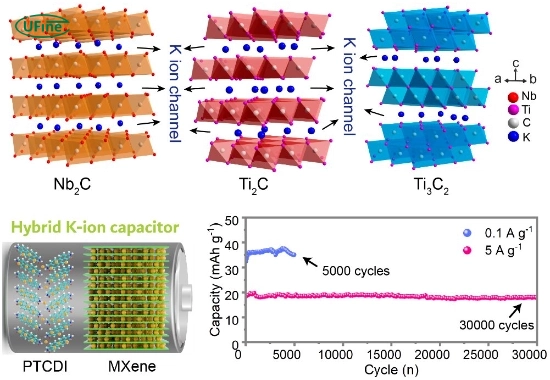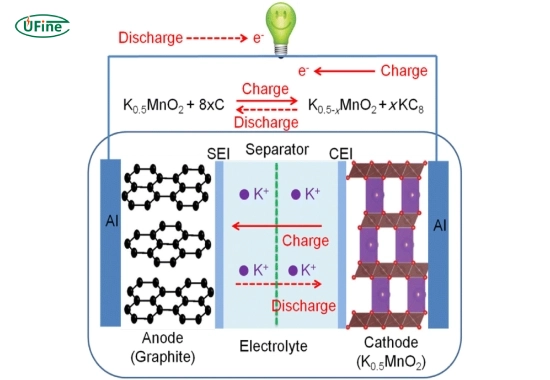Potassium ion batteries are generating much buzz in the energy storage world. These innovative batteries are emerging as a promising alternative to traditional lithium-ion batteries, offering benefits such as cost-efficiency, abundant resources, and fast charging. But what exactly is a potassium ion battery, and how does it work? This article will investigate potassium ion batteries’ science, benefits, and future applications. Whether you’re an energy enthusiast or just curious about new technologies, this guide is for you.
Part 1. What is a potassium ion battery?
A potassium ion battery (KIB) is a rechargeable battery that stores and releases energy using potassium ions (K⁺). Similar to lithium-ion batteries, they operate by moving ions between the anode (negative electrode) and cathode (positive electrode) during charging and discharging. However, instead of relying on lithium, these batteries use potassium, a more abundant and cost-effective element.
Potassium ion batteries are considered game-changers because potassium is widely available, inexpensive, and more environmentally friendly than lithium. This makes them a desirable option for sustainable energy storage solutions.
Part 2. How do potassium ion batteries work?
Potassium ion batteries transfer potassium ions between the anode and cathode through an electrolyte. Here’s a simplified explanation of the process:
- Charging phase: During charging, potassium ions move from the cathode to the anode through the electrolyte. The anode stores these ions, creating chemical energy that the battery can later use.
- Discharging phase: When the battery is used, the potassium ions return to the cathode, releasing the stored energy. This energy powers the connected device or application.
The movement of potassium ions is facilitated by the electrolyte, typically a liquid or solid material that allows ion conduction while preventing electrical short circuits.
Part 3. Key components of a potassium-ion battery
Let’s dive deeper into the specific materials used in each component of a KIB:
Anode Materials:
- Graphite: Similar to LIBs, graphite can be used as an anode material. However, potassium intercalation in graphite is more challenging than lithium.
- Hard Carbon: A disordered form of carbon that performs better with potassium ions than graphite.
- Potassium Alloys: Potassium alloys with other metals (e.g., Sn, Sb, Bi) are being explored as high-capacity anode materials.
Cathode Materials:
- Prussian Blue Analogs: These coordination compounds offer good electrochemical performance and are relatively inexpensive.
- Potassium Transition Metal Oxides: Potassium cobalt oxide (KCoO2) and potassium manganese oxide (KMnO2) are being investigated for their high voltage and energy density potential.
- Organic Materials: Organic compounds are also emerging as promising cathode materials due to their flexibility and sustainability.
Electrolytes:
- Liquid Electrolytes: These are solutions of potassium salts in organic solvents. They offer high ionic conductivity but can be flammable.
- Solid-State Electrolytes: These are solid materials that conduct potassium ions. They offer improved safety and stability. Examples include ceramics and polymers.
Part 4. What makes potassium ion batteries different from lithium-ion batteries?
At first glance, potassium ion batteries and lithium-ion batteries seem similar. Both rely on the movement of ions between electrodes. However, there are a few key differences that set them apart:
- Abundance: Potassium is much more abundant in the Earth’s crust than lithium, making it more affordable and sustainable in the long run.
- Cost: Lithium mining is expensive and resource-intensive. Potassium, being easier to extract and refine, significantly lowers production costs.
- Ion size: Potassium ions are more significant than lithium ions, which can lead to lower energy density in potassium ion batteries. However, their larger size allows for faster ion diffusion, resulting in quicker charging times.
- Stability: Potassium ion batteries are often considered more stable and safer than lithium-ion batteries, reducing the risk of overheating or explosion.
Artikel Terkait: Lithium-ion vs. Lithium Polymer Battery: Which is Better?
Part 5. What are the benefits of potassium ion batteries?
Potassium ion batteries offer several compelling advantages, making them a strong contender in the battery industry:
- Cost-efficiency: Potassium is cheaper and easier to source than lithium, reducing the overall production cost of batteries.
- Sustainability: With more abundant potassium, these batteries provide an environmentally friendly alternative to lithium-ion batteries.
- Fast charging: The larger size of potassium ions allows for quicker diffusion, which means faster charging speeds.
- Safety: Potassium ion batteries are less prone to overheating, making them a safer option for energy storage.
- Compatibility: These batteries can often use existing materials and infrastructure, reducing barriers to adoption.
Part 6. What are the limitations of potassium ion batteries?
Despite their advantages, potassium ion batteries are not without challenges. Here are some of the key limitations:
- Lower energy density: Potassium-ion batteries generally have a lower energy density than lithium-ion batteries. This means they may not store as much energy in the same space.
- Early-stage technology: Potassium ion batteries are still in the research and development phase. Mass production and widespread adoption are yet to be achieved.
- Electrode material compatibility: Researchers are working to solve the challenge of finding suitable materials for electrodes that can handle the larger potassium ions without degrading.
Part 7. What are the applications of potassium ion batteries?
Potassium ion batteries have the potential to revolutionize multiple industries. Here are some of their most promising applications:
- Renewable energy storage: These batteries could store energy from renewable sources like solar and wind, making green energy more accessible.
- Electric vehicles: While lithium-ion batteries dominate the EV market, potassium ion batteries could emerge as a cheaper and safer alternative.
- Portable electronics: Potassium ion batteries could power various consumer electronics from smartphones to laptops.
- Grid storage: Large-scale energy storage systems could benefit from the cost-efficiency and sustainability of potassium ion batteries.
Part 8. How do potassium ion batteries compare to other alternatives?
Potassium ion batteries are just one of many options being explored for energy storage. Here’s a quick comparison with other alternatives:
- Lithium-ion batteries: Higher energy density but more expensive and less sustainable.
- Sodium-ion batteries: Similar cost benefits to potassium ion batteries but with slightly lower performance.
- Lead-acid batteries: Affordable but bulky and less efficient.
- Solid-state batteries: Have high potential for safety and energy density. However, they are still expensive and in the early development stages.
Part 9. Are potassium ion batteries environmentally friendly?
Potassium ion batteries are considered more environmentally friendly than many existing battery technologies. Here’s why:
- Abundance of raw materials: Potassium is readily available, reducing the need for environmentally damaging mining practices.
- Recyclability: Research is ongoing to make these batteries easier to recycle, reducing their environmental impact.
- Less toxic: Potassium ion batteries use less toxic materials compared to some traditional battery chemistries.
Part 10. What is the future of potassium ion batteries?
The future of potassium ion batteries looks promising. These batteries will likely become more efficient and commercially viable with ongoing research and development. Key focus areas include improving energy density, extending cycle life, and scaling production.
As the demand for sustainable energy storage grows, potassium ion batteries are expected to significantly reduce reliance on lithium-ion batteries and support the global transition to renewable energy.
Part 11. FAQs
-
What is a potassium ion battery?
A potassium ion battery is a rechargeable battery that stores and releases energy using potassium ions. It is a cost-effective and sustainable alternative to lithium-ion batteries. -
Are potassium ion batteries better than lithium-ion batteries?
Potassium-ion batteries are more affordable and sustainable but have lower energy density than lithium-ion batteries. However, they charge faster and are safer. -
What are potassium ion batteries used for?
Potassium ion batteries can be used for renewable energy storage, electric vehicles, portable electronics, and grid storage systems. -
Are potassium ion batteries safe?
Potassium ion batteries are safer than lithium-ion batteries because they are less likely to overheat or catch fire. -
When will potassium ion batteries be widely available?
While still in the research phase, potassium ion batteries are expected to become commercially viable within the next decade as production technology improves.
Related Tags:
More Articles

How to Choose the Best Floor Scrubber Battery for Commercial Cleaning?
Selecting the ideal floor scrubber battery ensures a long runtime, rapid charging, and minimal maintenance for efficient commercial cleaning operations.
Battery for Blower vs Battery for Leaf Vacuum: Which One Should You Choose?
Battery for blower vs leaf vacuum—learn the key differences in power, fit, and runtime to choose the right battery for your outdoor tool needs.
How to Choose the Right Battery for Blower?
Choosing the right blower battery? Consider voltage, capacity, chemistry & usage. This guide helps match the best battery for peak performance.
How to Choose the Best Insulated Battery Box for Lithium Batteries?
Choosing the Best Insulated Battery Box for Lithium Batteries? Discover key factors such as size, material, and safety for optimal protection and performance.
7 Critical Elements on a Lithium Battery Shipping Label
What must be on a lithium battery shipping label? Learn 7 key elements to ensure safety, legal compliance, and correct handling across all transport modes.





